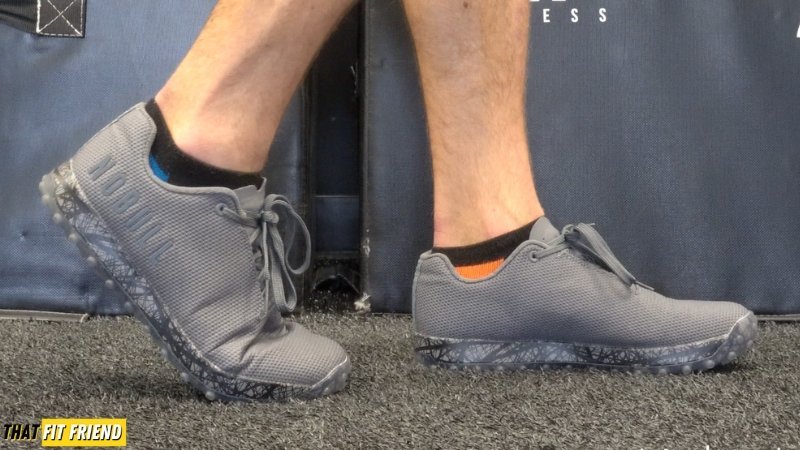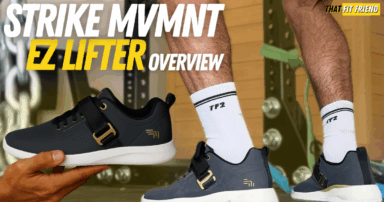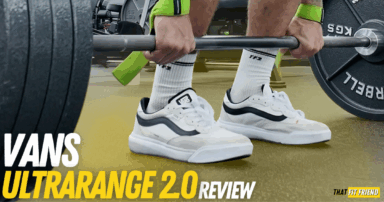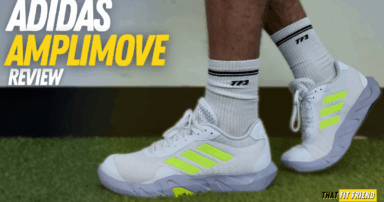On my YouTube channel, I’m asked fairly regularly about sock choice when working out. Questions around the topics of, “Should I wear socks when working out,” “what type of socks are ideal for cross-training”, and the list goes on.
I love this topic because sock choice and selection is a very individual question and dilemma. Much like selecting the perfect training shoes for your specific asks and needs, socks also should be selected based on individuality.
On a weekly basis, I vary my training a lot in the gym. For example, I cross-train and tackle CrossFit WODs, lift heavy, run, and train athletically with jumps and agility work, and I like my shoes, I rotate my socks based on what I’m doing and what I’m wearing.
In this article, I’m going to share how I approach the topic of sock choice for certain workouts and shoes. My goal is to not have you take this article as cookie-cutter information, but instead, help you develop a sock choice flow that works for you.
On the market for new cross-training shoes? Check out my That Fit Friend shoe finder. I built this calculator to help match you with training shoes that fit your workout needs best.
Common Socks Used for Working Out
Generally speaking, you’ll see three different types of socks used for working out. These three socks include crew socks, ankle socks, and no-show socks. Each of these socks has its own list of pros and cons.
More than likely, you have a preference when it comes to sock choice for certain workouts, but in the event, you’re not happy with your current socks, I’ll explain what each sock is and when I like to use each below.
Crew Socks
Crew socks are socks designed to come up higher on the leg and generally stop around the mid-calf area or just below it for most. These socks are designed to provide a moderate level of support and coverage regarding materials covering the skin.
Athletes and lifters will typically reach for crew socks when they’re doing endurance-focused work and they want a little more ankle support and material to cover the Achilles to prevent blisters. Lifters who like more ankle support also regularly reach for crew socks.
- When I Use Crew Socks: Breaking in shoes, running, outdoor workouts, trail runs, CrossFit WODs with rope climbs (protect the shin a little more!), and heavier lifting sessions where I want more material around my ankles.
- When Crew Socks Can Fall Short: Warmer workouts, sprint-focused training, and when wearing minimalist shoes.
If you’re constantly getting blisters on your Achilles from the top of your shoe’s boot causing friction during workouts, then crew socks could be a good sock option to try. Crew socks can also be great options for cooler weather.
Ankle Socks
Ankle socks are shorter socks that generally provide coverage up to about the malleolus (the circular bony structure on our lateral and medial ankle). Regarding length, most ankle socks will extend just past the boot in your shoes.
Lifters and athletes will often reach for ankle socks when they want something lighter and lower for their workouts. Ankle socks can be useful for endurance workouts, lifting, cross-training, and for warm weather sessions.
- When I Use Ankle Socks: Breaking in shoes, casual runs, CrossFit WODs, trail runs with easy terrain, athletic workouts, cross-training, lifting, and warm weather workouts outdoors.
- When Ankle Socks Can Fall Short: When wearing barefoot or minimalist shoes.
I would argue that ankle socks are probably the most popular sock used in the gym. They tend to look good with most workout shoes and provide a light layer of support and protection from blisters.
No-Show Socks
As their name suggests, no-show socks are socks designed to not be seen when worn. These are socks that will be thinner and more breathable in nature and their ankle cuff will usually will sit low on the ankle or foot and be hidden by a shoe’s boot.
Athletes and lifters will most commonly reach for no-show socks when they prefer a “minimalist” feel with their sock choice when training or if they want to hide their socks completely.
- When I Use No-Show Socks: Warm weather workouts, cross-training minimalist/barefoot shoe use, lifting, HIIT training, and athletic-focused training where I’m sprinting, jumping, and moving explosively.
- When No-Show Socks Can Fall Short: When breaking shoes in, when heel slip is more prevalent, cold weather workouts and trail runs.
I personally love no-show socks and wear them the most often when training once I break in shoes. For context, I’ll typically avoid wearing them during the first week or two of breaking in new training shoes to avoid any potential of getting blisters.
Should You Wear Socks While Working Out?
When considering using socks for working out, there really isn’t a “one-size-fits-all” answer. There are multiple factors that can dictate whether you should or shouldn’t wear socks while working out.
In my opinion, there are three factors that can influence whether you wear or don’t wear socks while working out. I’ll also discuss nuances and things to consider within each of these factors to help you decide whether you should or shouldn’t wear socks for training.
1. Consider the Shoes You’re Working Out In
First, consider the workout shoes you’re wearing and assess their support and internal construction. Every shoe is built slightly differently and the internal construction, insole, and durability of the inside of shoes can vary pretty greatly.
If you’re wearing shoes that have a lot of volume with their upper and you find that you’re swimming in the shoes without socks, then you’d want to likely wear socks when working out. Basically, consider your shoe’s fit and your foot anatomy.
A good example of this would be someone wearing a Reebok Nano X2 with a narrower foot. For this example, the athlete may find that they’re sliding around while training because they don’t have a large enough foot to fill the shoe.
Conversely, if you’re wearing shoes that fit more snuggly and hug the feet well, then you may find you enjoy training in the shoes without socks. For example, I’ll train sockless in my APL TechLoom Tracer because they have a snugger sock-like fit, to begin with.
Another example of when you’d likely want to wear socks for working out is if your shoe doesn’t have an insole or there is exposed stitching on the inside that may break down faster while training barefoot in the shoes.
Sweaty feet can increase friction on internal materials, so taking a peak at the inside of your shoes can be an easy way to assess their potential long-term durability if you decide you want to train sockless more often than not.
Side note, if you’re prone to stinky feet or find that your shoes tend to get smelly fast, then socks will likely be your best bet to prevent stink in your shoes. If you want to go sockless in workout shoes and tend to have smelly feet, try to find models that have anti-odor tech built in.
The last thing to consider when thinking about your shoes is their level of support and if it feels more or less natural to use them with or without socks. This is a factor that will be preferential and simply experimenting can be your best bet for assessing this.
2. Consider the Weather You’re Working Out In
On top of shoe choice, weather can also play a large role in helping you navigate whether you should work out in socks. When factoring in weather to your sock choice, comfort should be the main driver for helping you decide.
If you’re working out in hot gyms or settings and you want to wear socks, then you’ll likely want to explore ankle or no-show socks since these socks will generally be the most breathable option for training.
In hotter climates, you can also sockless train more comfortably than in other settings. For this case, I’d cross-reference the weather/climate you’re training in with the shoes you’re wearing.
For colder months socks can be a safe bet for keeping the feet warmer and giving you a little more support and compression which can help with performance by creating more warmth.
3. Consider Your Feet and If You Need Special Socks
Another thing to consider when opting for socks for working out is if you have a foot condition that socks can help with. For example, if you wear special shoes and socks to support your feet and comfort, then you’ll want to wear socks over not wearing them.
Great examples of this are if you have a condition like Athlete’s Foot or Plantar Fasciitis and need to wear socks for additional support or to help the condition go away faster.
Obviously, with specific foot conditions, follow a medical professional’s advice when deciding on socks or no socks for working out.
Can You Work Out Without Socks?
You can absolutely work out safely in training shoes without socks. If you like to train without socks, then the bigger thing to consider is the shoes you’re wearing and how they interact with the feet during your style of training.
I touched on this above, but I’d suggest letting your shoe’s fit, support, and durability influence your sock use with them. If your shoes provide you with a good level of support and you’re not sliding around in them when lifting, jumping, and tackling your workouts, then you should be good to go when opting for sockless sessions.
Workouts, where I’d suggest giving pause to going sockless, are sessions where you’re running or doing workouts where there’s a heavier endurance or explosive bias. For these sessions, socks can be awesome for blister prevention and giving you additional support.
Outside of training shoes, if you’re wearing minimalist and barefoot shoes, then you’ll also want to consider going sockless when training. Barefoot shoes like the Tolos Archetype 2.0 and Vivobarefoot Primus Lite III are both options that feel more natural with sockless use.
Should You Wear Socks While Running?
While you don’t necessarily need socks for running, it’s an activity where I think most will actually want a pair of socks on for their workout. Of all the exercises and activities you can perform, I find running to be the one workout where I really prefer sock use.
Socks can be useful for running for three key reasons. First, they can help prolong the durability of the inside of your running shoes. Running can produce a lot of stress on shoes and sweaty feet sliding around running shoes can cause them to break down faster at times.
More specifically, I find that running sockless can result in breaking down a running shoe’s insole faster. For example, if your bare feet are causing the insole to slide around your shoes while you’re running, then you can lose out on its shape and security. Sliding insoles can be really frustrating.
Second, since running is such a repetitive activity that creates a lot of stress on certain areas of the feet and ankles, depending on your running mechanics, running sockless may result in more blisters.
Socks are nice when running because they serve as a baseline layer of protection from the friction that can be caused by the backs of running shoes. They can also help prevent any form of rub or blistering of the top of the big and pinky toes.
Third and lastly, socks can give you another layer of cushion and support when running. Different socks can offer different levels of cushion and compression depending on which socks you prefer to use.
For most runs, I like to opt for ankle socks because they offer a nice light layer of protection from blisters, provide a little extra cushion for my run, and help keep my feet warm when running in cooler wear. Sock choice should be comfort and preference driven for running.
If you’re running in minimalist shoes, then you can typically get away with going sockless or wearing no-show socks. I’ll select one of these options based on the barefoot shoes I’m running in.
Frequently Asked Questions (FAQ)
Q:Should you wear socks while working out?
Q:Can you work out without socks?
Takeaway Thoughts
Socks, just like the shoes you workout in, should be selected based on the individuality of your preferences. Different workouts will have different demands on your shoes and your socks.
In my opinion, socks often get overlooked in the gym, and using the right pair can not only save you from blisters but also increase your comfort while training.
If you have additional about socks for working out, feel free to drop a comment below. I’m constantly experimenting with my sock choice in the gym and I’ll try to help you out where I can.
























CS
As for workout shoes, the first two years I started out wearing Converse low top sneakers for weight training and some other workouts at the gym, outside of cardio treadmill runs. I have since upgraded to the Nobull Trainer, or Trainer + sneakers to my CrossFit routine.
Living in warm climates, wearing sandals was the norm, thus the thought of sock use was not really given thoughtful consideration. I can say I was fully in the “sockless” camp at the time. I still am for less movement involved workouts. I have found Injinji no show toe socks to work well vice a no sock at all to wick sweat efficiently and keep the shoes from quickly stinking up as I increased my workout activities. I once wore a pair of light forest green colored shoes without socks for a CrossFit session, notable dark sweat moisture was visible on the top by the toe area and outside the arch areas of the shoe. No blistering though. That is when one person recommends the Injinji socks. Wearing the same shoes for the same type of workout session, wearing the socks prevented the moisture transfer to the outside of the shoe. Therefore, I opt for wearing socks now for the past few years for these higher intense workouts.
Love it!